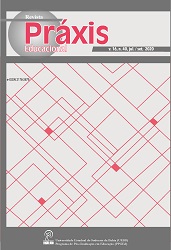IL DIRITTO DI GIOCARE: UNA NECESSITÀ PER I BAMBINI, UN POTENZIALE PER SCUOLA E LA CITTÀ
DOI:
https://doi.org/10.22481/praxisedu.v16i40.6899Palavras-chave:
Bambini, Scuola, Diritto a giocare, CitáResumo
Il principale interrogativo affrontato nell’articolo: perché e come il gioco dei bambini dovrebbe essere considerato un importante parametro nelle politiche urbane? Una possibile risposta a questo problema si trova in tutto il testo. Voglio iniziare tratteggiando la più recente evoluzione (o piuttosto involuzione) della struttura e della organizzazione urbana enfatizzando come questa definisce un ambiente che è proibito ed ostile per i bambini a meno che siano accompagnati dagli adulti; riassumerò l’impatto di un simile ambiente sul gioco e quindi sullo sviluppo dei bambini, accentuando le diverse caratteristiche della mobilità spaziale nei bambini e negli adulti, e l’estremo pericolo di isolare i bambini dall’esperienza del pericolo che costituisce una caratteristica paradossale della educazione di oggi. Proporrò un’alternativa radicale alla corrente politica urbana in cui i bambini e il loro gioco sono il principale focus, piuttosto che un marginale e non conosciuto problema da essere considerato solo come un ripensamento, e presenterò alcuni casi concreti nei quelli una simile alternativa è stata messa in pratica da bambini e politici insieme, e i suoi effetti sono stati testati e valutati. In conclusione esperienze simili sembrano giustificare una moderata quantità di speranza per il futuro delle nostre città, nonostante le loro preoccupanti condizioni attuali.
Downloads
Referências
BARALDI, C., MAGGIONI, G.(eds.). Una città con i bambini, progetti ed esperienze del Laboratorio di Fano, Roma: Donzelli Editore, 2000.
BATESON, G., The Message “This Is Play”, New York: Josiah Macy Jr. Foundation, 1956.
BAUMAN, Z., The individualized society, Cambridge: Polity Press, 2001.
BENCIVENGA, E. Giocare per forza. Critica alla società del divertimento, Milano: Mondadori, 1995.
BENCIVENGA, E. Tre dialoghi, Torino: Bollati Boringhieri, 1988.
BLAKELY, K. S. ‘Parents’ conceptions of social dangers to children in the urban environment’ Children’s Environments 11, 1994. p. 16-25.
BOZZO, L. ‘Il gioco e la città’, Paesaggio urbano 2, 1995, p. 30-33.
BRUNER, J. S. ‘Nature and uses of immaturity’, in J. S. Bruner, A. Jolly, K. Silva (eds.), Play. Its role in development and evolution, New York: Basic Books, 1976.
CAILLOIS, R. Les jeux et les hommes, Paris: Gallimard, 1967.
CHAWLA, L. Growing up in an urbanizing world, Paris/London: Unesco Publishing/Earthscan, 2001.
DE SAINT-EXUPÉRY, A. Le Petit Prince, Paris: Gallimard, 1943.
GARLING, T., VALSINER, J. (eds.): Children within environment: Toward a psychology of accident prevention, New York: Plenum Press, 1985.
GARVEY, C. Play, Cambridge: Harvard University Press, 1977.
GERMANOS, D. ‘La relation de l'enfant à l'espace urbain: perspectives educatives et culturelles’, Architecture & Comportement 2, 1995, p. 54-63.
GOMBRICH, E. H. Meditations on a hobby horse and other essays on the theory of art, London: Phaidon, 1971.
HART, R. Children’s Participation: The Theory and Practice of Involving Young Citizens in Community Development and Environmental Care, London: Earthscan Publication Limited, 1997.
HILLMAN, M. (ed.). Children, transport and the quality of life, London: Policy Studies Institute, 1993.
HUIZINGA, J. Homo Ludens, Amsterdam: Panteon Verlag, 1939.
KLINE, S. ‘The promotion and marketing of toys: Time to rethink the paradox?’. In: PELLEGRINI, A. The future of play theory, Albany: State of New York University Press, 1995.
LOCKE, J. Some thoughts concerning education, Indianapolis/Cambridge: Hackett Publishing Company (orig. ed. 1693), 1996.
LYNCH, K. ‘The Spatial World of the child’, in W. Michelson, S.V. Levine, E. Michelson (eds.), The child in the city: Today and tomorrow, Toronto: Univerity of Toronto Press.
MANN, M. Incoherent empire, London: Verso Books, 1979/2003.
MARILLAUD, J. ‘Jeu et securité dans l'espace pubblic’, Architecture & Comportement 7, 1991, p. 137-145.
MUMFORD, L. ‘La pianificazione per le diverse fasi della vita’, Urbanistica 1, 1945, p. 7-11.
PIAGET, J. La formation du symbole chez l’enfant, Neuchâtel: Delachaux et Niestlé, 1945.
PREZZA, M., ALPARONE, F. R., RENZI, D., PIETROBONO, A. Social Participation and Independent Mobility in Children: The Effects of Two Implementations of ‘‘We Go to School Alone’’, Journal of Prevention & Intervention in the Community, 38, 2010, p. 8–25.
PREZZA, M., PILLONI, S., MORABITO, C., SERSANTE, C., ALPARONE, F. R. ‘La mobilità autonoma dei bambini nel contesto urbano e il cortile, il parco e la strada privata come spazi di gioco’, Psicologia della salute 3, 2000, p. 81-97.
RISSOTTO, A., TONUCCI, F. ‘Freedom of Movement and Environmental Knowledge in Elementary School Children’, Journal of Environmental Psychology 22, 2002, p. 65-77.
SHAW, B., WATSON, B., FRAUENDIENST, B., REDECKER, A., JONES, T., HILLMAN, M. Children’s independent mobility: a comparative study in England and Germany (1971 - 2010), London: Policy Studies Institute, 2013.
SPINKA, M., NEWBERRY, R. C., BEKOFF, M. ‘Mammalian play: Training for the unexpected’, Quarterly Review of Biology 76, 2001, p. 141-168.
SUTTON-SMITH, B. The ambiguity of play, Cambridge: Cambridge University Press, 1997.
SUTTON-SMITH, B. Toys as culture, New York: Gardner Press, 1986.
TAYLOR, A . F., WILEY, A., KUO, F. E., SULLIVAN, W. C. ‘Growing up in the Inner City: Green Spaces as Places to Grow’ Environment and Behavior 30, 1998, p. 3-27.
TONUCCI, F. La città dei bambini, Bari: Laterza, 1996.
TONUCCI, F. Se i bambini dicono: adesso basta!, Bari: Laterza, 2002.
TONUCCI, F., RISSOTTO, A., ‘Why Do We Need Children's Participation? The Importance of Children's Participation in Changing The City’, Journal of Community and Applied Social Psychology 11, 2001, p. 407-419.
VYGOTSKY, L. S. ‘Play and its role in the mental development of the child’, Soviet Psychology 12, VI, 1966.













